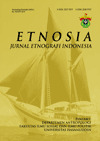Abstract
Language and cultural richness of Biak Numfor in Papua is part of a national identity characterized by "Bhineka Tunggal Ika" (Unity in Diversity) as the basic foundation in building Indonesia. This article aims to reveal the identity system of speech in a community of Biak Numfor, Papua from an anthropolinguistic perspective. While the theoretical approach is an exploration of anthropolinguistic theory, the methodological approach is a descriptive one with an explanative dimension. From an anthropolinguistic perspective, this study seeks to apply scientific principles of socio-cultural data and adapt the steps in scientific studies to other fields of science. This study follows several stages, including providing data, analyzing data, presenting the results of the analysis. As a result, we holistically identify problems that refer to the system of phonology, naming and dialect differences, morpheme interference, syllable patterns, phoneme series, numeralia, unit of measurement, time unit, language vitality, language and culture migration, ritual tradition, dou tradition, faith, social unity and place of living, social stratification, marriage, kinship, legal culture (adat), legal sanctions, and forest ecology. The practical implication of this study is that it can be used as a basic reference in human resource development in Biak Numfor Regency. In addition, since anthropolinguistic theory has not been able to codify all language and socio-cultural systems, we suggest that theoretical collaboration in other fields is needed to complement the development of the theory.References
Blust, Robert A. (1978). “Eastern MalayoPolynesian: A Subgrouping Argument” dalam SA Wurm and Lois Carrington (eds). Second International Conference on Austronesian Linguistics Proceedings. Pacific Linguistics Series C (61): 181-234.
Duranti, A. (1997). Linguistic Anthropology. Cambridge: Cambridge University Press.
Duranti, A. (2003). Language as Culture in U.S. Anthropology: Three Paradgims. The Wenner-Gren Foundation for Anthropological Research: Current Anthropology, 44 (3), 323-347.
Fautngil, Christ dan F. Rumbrawer. (2001).Tata Bahasa Biak. Jakarta: Yayasan Servas Mario.
Foley, W. A. (1997). Anthropological Linguistics: An Introduction. Blackwell Publishing: Oxford.
Farid, Hilmar. (2016, Mei 16). Strategi Kebudayaan Pembangunan “Indonesia Sentris”. http://presidenri.go.id/program-prioritas-2.
Hardyanto. (2018, Ferbruari 28). Indonesia-Bahasa-Dunia. Http://setkab.go.id/indonesia-bahasa-dunia).
Held, G.J. (2006). Waropen dalam Khasana Budaya Papua (The Papuas of Waropen) (Dharmojo, 2006). (Terjemahan). Pasuruan: Penerbit Pedati.
F.C. Kamma. 1974. Ajaib di Mata Kita, Jilid I. Jakarta: BPK Gunung Mulia-PERSETIA.
F.C. Kamma. 1981. Ajaib di Mata Kita, Jilid II. Jakarta: BPK Gunung Mulia-PERSETIA.
Mansoben, Jos R. (2003). Sistem Politik Tradisional Etnis Byak: Kajian tentang Pemerintahan Tradisional. Jurnal Antropologi Papua, 1(3:1-30.
Mansoben Jos R. (1994). Sistem Politik Tradisional Irian Jaya, Indonesia: Studi Perbandingan. Jakarta LIPI RUN.
Pondayar, Yustus. (2007). “Cara Penyelesaian Delik Adat Suku Biak Numfor - Papua”. Tesis Magister Hukum. Denpasar: PPS UNUD.
Steinhauer, H. (1985). ‘Number in biak: counterevidence to two alleged language universals’, in Bijdragen tot de Taal-, Land-en Volkenkunde, 141(4): 462-485, from http://www.kitlv-journals.nl
Tilaar, H. A. R. (2007). Mengindonesia Etnisitas dan Identitas Bangsa Indonesia. Jakarta: Rineka Cipta.
Thomas, Linda dan Shan Wareing. (2007). Bahasa, Masyarakat dan Kekuasaan (Terjemahan). Yogyakarta: Pustaka Pelajar.
Usmani, Desy Pola. (2014). “Pelayaran Orang Biak Numfor Sebelum Abad 19: Suatu Tinjauan Maritim” dalam Jurnal Budaya, 19 (2), 199-216.
Warami, Hugo. (2006). “Dou Sandik Guyub Tutur Biak Numfor, Papua”. Tesis Magister S2 Linguistik Kebudayaan. Denpasar: PPS UNUD.
Warami, Hugo, Sientje Latuputty dan Yulianus Awak. (2013). Satu Abad Pekabaran Injil di Wadibu-Biak Timur (1913-2013). Manokwari: Pusbadaya UNIPA.
Warami, Hugo. (2014a). "Simbolisme Visual Tata Rias Pengantin Suku Biak Numfor: Kajian Semiotika Budaya". Jurnal Tifa Antropologi:Jurnal Ilmiah Etnografi Papua, 2 (2): 333-343.
Warami, Hugo. (2014b). "Tradisi Dou Sandik: Cermin Identitas Guyub Tutur Biak Numfor Papua". Jurnal Kibas Cenderawasih: Jurnal Ilmiah Kebahasaan dan Kesastraan, 11 (1): 1-10.
Warami, Hugo. (2016). “Vitalitas Bahasa Biak di Era Otonomi Khusus Papua: Perspektif Ekolinguistik” dalam Prosiding Seminar Nasional Bahasa Ibu IX, Program S2 & S3 Linguistik UNUD, Denpasar, 26-27 Februari 2016. Denpasar: Udayana University Press.
Warami, Hugo. (2017). "Pengetahuan Kesaguan Guyub Tutur Biak Numfor-Papua". Jurnal Melanesia: Jurnal Ilmiah Kajian Bahasa dan Sastra, 01 (2): 117-124.
Warami, Hugo. (2018). “Migrasi Bahasa dan Budaya Biak: Perspektif Antropolinguistik. Seri Pembelajaran bagi Sub Etnik Bar Byak, Numfor, Doreri, Amberbaken, Roon, dan Raja Amapat (Bindara)”. Makalah Musyawarah Ikatan Keluarga Besar BINDARA Kabupaten Teluk Bintuni Provinsi Papua Barat. Bintuni, 20 November 2018.

This work is licensed under a Creative Commons Attribution-NonCommercial 4.0 International License.
Copyright (c) 2020 ETNOSIA : Jurnal Etnografi Indonesia





